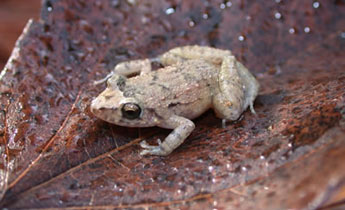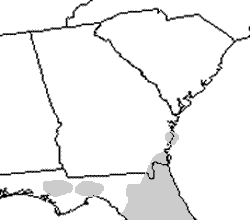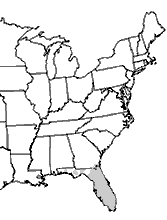Greenhouse Frog (Eleutherodactylus planirostris) – Introduced



Photos by J. D. Wilson unless otherwise noted
| Description: Greenhouse frogs are very tiny frogs at only 12-30 mm (0.5-1.2 in) in length. The background color is typically brown, reddish-brown, or bronze. They have two pattern phases: mottled with dark and light markings, often with faint chevron-shaped bands on the back and between the eyes, and striped with two light longitudinal stripes on the back. The eyes are red, the belly is gray or white with the occasional dark spot, and there is no webbing between the toes.
Distribution and Habitat: This species of frog is native to Cuba, the Bahamas, and possibly other islands in the West Indies. It likely made its way from Cuba to Florida and Georgia as a stowaway in tropical plant shipments. Greenhouse frogs are widespread in Florida and have additionally been introduced in Jamaica, the Cayman Islands, some of the Bahamas, and in the area around Veracruz, Mexico. There are isolated records in the Florida panhandle, New Orleans, Louisiana, southern Alabama, and coastal and southern Georgia. They occur in both residential areas and in a wide range of natural terrestrial habitats. Greenhouse frogs aren’t big climbers; they prefer to remain close to the ground in warm, humid areas with moist ground cover and other suitable hiding places. Reproduction and Development: Breeding in greenhouse frogs occurs during spring and summer (May-September) in northern Florida) in damp clumps of vegetation, under debris, in leaf litter, and in the soil of potted plants. The mating season is shortened at both ends in higher latitudes. Males usually only call on rainy nights, although their call can also be triggered by sprinklers. Their voice consists of a series of short, bird-like chirps, with an average of 4-6 in a series. This species is one of only two east of Texas that lay their eggs on land. Approximately 20 eggs are deposited under damp vegetation or debris, and the female frequently remains to watch after them. The eggs hatch directly into froglets about two weeks after they are laid- there is no tadpole stage. The young emerge with a small tail nub and are less than ¼ inch long. Sexual maturity is reached within a year. Habits: A terrestrial species, the greenhouse frog is most active at night, during or just following rain. During the day or a dry spell, they seek the shelter of boards, leaves, logs, trash, or other debris where there is moisture. They are also found in gardens, greenhouses, dumps, hardwood hammocks, gopher tortoise burrows, and small stream valleys. Although the home range size is unknown, this species disperses with ease and is quite abundant in certain locations. Individuals travel from one area to the next via potted plants, gardening supplies, and other household items. The diet of greenhouse frogs consists of small invertebrates such as ants, beetles, spiders, earthworms, and mites. Known predators include the invasive Cuban treefrogs and ringneck snakes, though other species of snakes, frogs, and birds also likely prey upon these frogs. Conservation: While the greenhouse frog seems relatively harmless in comparison to other nonnative species, competition with native amphibians or small reptiles for insects may occur. They could also adversely affect the diversity of indigenous insects. It is clear that the primary conservation concern with this species lies with how quickly it disperses as a result of human activities and its effect on native species where large populations have become established. Pertinent References: Dorcas, Mike, and Whit Gibbons. Frogs and Toads of the Southeast. Athens: University of Georgia, 2008. Jensen, John B., Carlos D. Camp, Whit Gibbons, and Matt J. Elliott. Amphibians and Reptiles of Georgia. Athens: University of Georgia, 2008. Account Author: Lindsay Partymiller |
